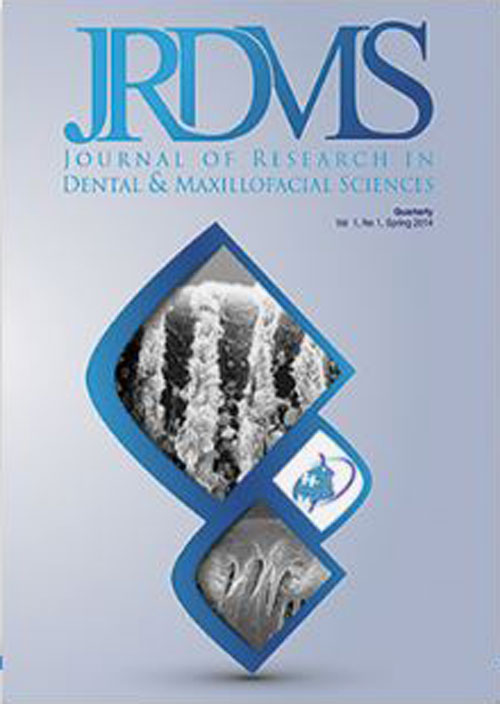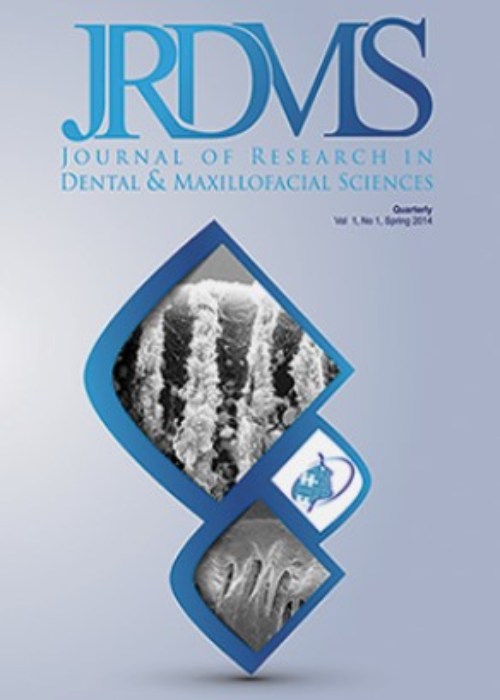فهرست مطالب

Journal of Research in Dental and Maxillofacial Sciences
Volume:6 Issue: 3, Summer 2021
- تاریخ انتشار: 1400/04/23
- تعداد عناوین: 7
-
-
Pages 1-7Background
Occlusion analysis in the primary dentition period can predict the occlusion of permanent dentition. This study aimed to assess the frequency of malocclusion in primary dentition period in 3 to 5-year-old preschoolers in Isfahan city, Iran.
Materials and MethodsThis descriptive, cross-sectional study analyzed the occlusion of primary teeth in 400 children between 3 to 5 years who were selected from 8 kindergartens in Isfahan city during 2019-2020. The dentition of children was clinically examined by a dental mirror and a tongue blade after obtaining consent from the parents. The children had all the primary teeth with no permanent tooth, and had no extraction in their treatment plan. The primary molar relationship, canine relationship, and anterior or posterior crossbite, overbite and overjet were all assessed and recorded. Data were analyzed using the Chi-square, Kruskal-Wallis, and Fisher’s exact tests.
ResultsOf all, 82.75% of the children had flush terminal plane (FTP), 10.25% had distal step, and 6% had mesial step. Class I canine relationship had the highest prevalence (87%) followed by class II (8.25%) and class III (4%). The frequency of increased overjet was 14.25%. Deep bite (15%) was the most prevalent malocclusion. Anterior and posterior crossbite had 6.25% prevalence.
ConclusionRelatively high prevalence of malocclusion in our study population calls for in-time assessment of primary occlusion for timely detection and management of malocclusions in the primary dentition period to prevent their aggravation.
Keywords: Dental Care, Dental Occlusion, Malocclusion -
Pages 8-18Objectives
Attempts are ongoing to simplify the bonding procedure by decreasing the procedural steps. Universal adhesives were introduced to serve this purpose. This study aimed to evaluate the push-out bond strength of glass fiber posts in endodontically-treated teeth with two universal adhesives.
Materials and MethodsIn this in vitro, experimental study, 22 single-rooted mandibular premolars were decoronated at their cementoenamel junction, endodontically treated and were randomly divided into two groups. The G-Premio Bond was used in the first and All-Bond Universal was used in the second group, according to the manufacturers’ instructions. Angelus fiber posts were cemented using RelyX U200 Automix self-adhesive resin cement. The roots were cut into 1-mm-thick sections perpendicular to the longitudinal axis of the tooth in the cervical, middle, and apical thirds. The push-out test was performed in a universal testing machine at a crosshead speed of 1 mm/min, and bond strength values were recorded. The failure modes were also determined. The data were analyzed using ANOVA and linear mixed models.
ResultsThe mean push-out bond strength was significantly higher in All Bond Universal than
G-Premio Bond (P=0.036). Also, there were statistically significant differences in the push-out bond strength of adhesives in different parts of the root canal (P=0.039). All failures were type 4 in both groups (adhesive failure between the dentin and resin cement).ConclusionAll Bond Universal yielded superior push-out bond strength than G-Premio. However, further in vitro and in vivo studies with larger sample size are required for an evidence-based decision making.
Keywords: Bond Strength, Endodontically Treated Teeth, glass Fiber Posts, Push-Out Test, Universal Adhesive -
Pages 19-24Background and Objectives
Smoking is a hazardous habit with numerous adverse effects on oral health. It plays an important role in development of cancerous and precancerous lesions and periodontal disease. Saliva has an antioxidant system and several enzymes. This study aimed to assess the salivary levels of uric acid (UA), lactate dehydrogenase (LDH), and amylase in smokers versus non-smokers.
Materials and MethodsThis descriptive, cross-sectional study was conducted on 60 individuals (30 smokers and 30 non-smokers) at the Dental School of Islamic Azad University. The participants were requested to refrain from smoking, eating and drinking prior to saliva sampling. A minimum of 1 cc of unstimulated saliva was collected from each participant by the spitting method. The level of salivary LDH was measured by the DGKC method, the level of UA was measured by the uricase assay, and the level of amylase was quantified by the kinetic photometric method. Data were analyzed by t-test, Chi-square test, Fisher’s exact test, and Mann-Whitney test (P<0.05).
ResultsThe salivary level of UA was 1.35±1.2 mg/dL and 1.08±1.05 mg/dL in smokers and nonsmokers, respectively with no significant difference (P=0.08). The salivary levels of amylase and LDH were 44509±38062 U/L and 420±244 IU/L in smokers and 47299±29659 U/L and 538±350 IU/L in non-smokers, respectively, with no significant difference (P>0.05).
ConclusionDespite the slightly higher level of salivary UA in smokers, the difference between smokers and non-smokers was not significant in any of the tested parameters.
Keywords: Uric Acid, Lactate Dehydrogenase, Amylase, Cigarette Smoking -
Pages 25-30Background and Aim
Tooth eruption is a multifaceted physiological process, which can be delayed by factors such as malnutrition. This study aimed to compare the serum levels of vitamin D and calcium in infants with a longer than normal eruption time of the first deciduous tooth with the control group (normal eruption).
Materials and MethodsIn this case-control study, serum levels of vitamin D in 61 children with a mean age of normal dental eruption in Iranian children (8 months and less) were compared with 61 children with eruption age of more than 8 months. The children were matched in terms of age, sex, place of birth and residence, age of birth, birth weight, and other eruption-related items. Studentchr('39')s t-test, analysis of variance (ANOVA), and chi-square test were used for statistical analysis.
ResultsThe first erupted tooth in all infants was the mandibular incisor. The mean serum level of vitamin D was 38.1±24.1 ng/ml in infants with eruption age of 8 months or less and 40.0±21.5 ng/ml in the group of eruption age over 8 months (P=0.63). Serum calcium level was 10.03±0.55 mg/dl in the first group and 9.92±0.57 mg/dl in the second group (P=0.28). There was no significant relationship between gender, maternal education, A+D supplementation, infant nutrition (breast milk, formula, and combination), and different levels of vitamin D (deficient, inadequate, adequate, and toxic) with the average age of eruption of the first deciduous tooth (P>0.05).
ConclusionIt seems that serum vitamin D and calcium levels in this age group do not affect the eruption time of deciduous teeth.
Keywords: Eruption, Deciduous Tooth, Serum, Vitamin D, Calcium -
Pages 31-39Background and Aim
This study compares a new technique for teeth alignment to the conventional method. The teeth were aligned using an open-coil spring, i.e. simultaneous space opening and alignment, on round nickel-titanium (NiTi) archwires. The purpose of this 2-arm parallel trial (1:1 allocation ratio) was to evaluate the alignment efficiency of conventional and open-coil spring techniques in anterior crowding treatment.
Materials and MethodsIn this clinical trial study, sixty-two non-extraction patients (70 dental arches: 24 upper arches and 46 lower arches) with ≥3mm of Little’s Irregularity Index (LII) were recruited in two groups based on the minimization method. Blinding was applicable for outcome assessment only. In one group, the teeth were aligned using an open-coil spring, whereas the alignment in the other group was done conventionally, (space opening on steel wires followed by alignment with an auxiliary NiTi wire). The alignment duration was the primary outcome that was investigated for survival analysis and alignment rate ratios, and levels of crowding were calculated with Cox proportional hazard regression. The pre- and post-treatment intercanine widths were also recorded as the secondary outcome. The chi-square and t-test were used to compare other variables between the groups. The level of statistical significance was set at P<0.05.
ResultsThere was no significant difference in the alignment duration between the conventional (185.48±74.82 days) and open-coil (179.19±64.15 days) groups (P=0.725). No harm was detected using the mentioned methods.
ConclusionThe use of open-coil spring over brackets on NiTi or steel wires does not seem to affect anterior crowding treatment time.
Keywords: Alignment, Anterior Crowding, Randomized Clinical Trial, Tooth Movement -
Pages 40-44
Post-endodontic treatment pain is a major problem in dentistry. Around 80% of patients who present with preoperative pain due to endodontic treatment continue to experience the pain of some level following endodontic therapy. This pain, mostly linked to chronic inflammation, is due to bacterial toxins that signal the ingress of immune cells followed by the activation of various cytokines and inflammatory mediators. Countless classes of drugs have been studied to resolve this challenge. Glucocorticoids have been in use for more than fifty years owing to their potent anti-inflammatory effects. This paper aims to review the pharmacology and mechanism of actions of steroids as an intracanal medicament considering the indications, contraindications, and side effects.
Keywords: Ledermix, Triamcinolone, Postoperative Pain, Hydrocortisone -
Pages 47-51
Post-endodontic treatment pain is a major problem in dentistry. Around 80% of patients who present with preoperative pain due to endodontic treatment continue to experience the pain of some level following endodontic therapy. This pain, mostly linked to chronic inflammation, is due to bacterial toxins that signal the ingress of immune cells followed by the activation of various cytokines and inflammatory mediators. Countless classes of drugs have been studied to resolve this challenge. Glucocorticoids have been in use for more than fifty years owing to their potent antiinflammatory effects. This paper aims to review the pharmacology and mechanism of actions of steroids as an intracanal medicament considering the indications, contraindications, and side effects.
Keywords: Ledermix, Triamcinolone, Postoperative Pain, Hydrocortisone


